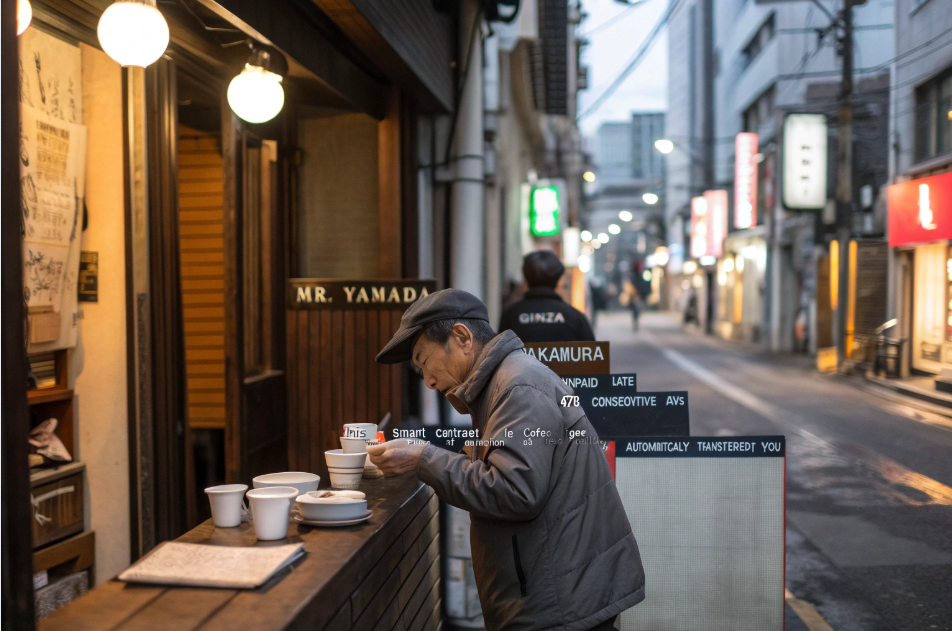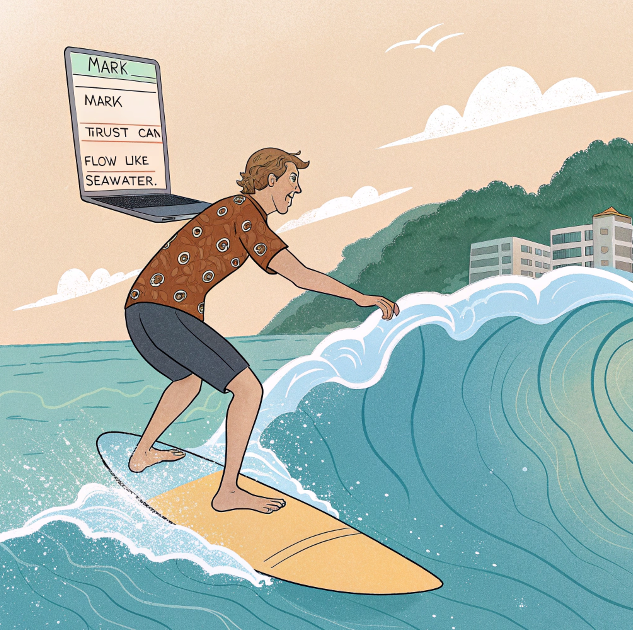On the streets of Tokyo at seven in the morning, Mr. Yamada wipes his coffee cup just as he has for the past twenty years. This coffee artisan in a Ginza alley has an unwritten rule: regular customers can run a tab. The worn notebook on the wooden bar records architect Mr. Nakamura's outstanding latte bill for 478 consecutive days, embodying the most primitive trust contract among urban dwellers.
This tacit understanding, built on eye contact and the rhythm of breathing, is gradually eroding in the wave of the digital age—until one day, Nakamura showed Yamada a flickering code interface on his phone: "This is a coffee ledger written with a smart contract. If I default, my NFT collection in the digital art museum will automatically transfer to you." 
This subtle moment between a traditional craftsman and a digital nomad aptly reflects the spectrum of change in our era. Smart contracts are no longer obscure terms in geek forums; they are reshaping the underlying logic of human collaboration, just as double-entry bookkeeping gave rise to modern commercial civilization in the fifteenth century.
As code begins to take on the multiple roles of notary, arbitrator, and executor, we may be witnessing the most significant evolution of contract forms since the invention of writing.
Mark, a German programmer surfing in Bali, completed a cross-border housing rental last month with seven lines of Solidity code. At the moment he flipped on the wave, the smart contract was automatically verifying the tenant's blockchain credit score, calculating the deposit interest, and dynamically binding the IoT data of the house with the rent payment.
This practice of "code as law" made Mark softly exclaim under the tropical sun: "It turns out trust can flow like seawater." The essence of this liquidity is that smart contracts transform interpersonal trust into programmable mathematical consensus, just like putting Mr. Yamada's coffee ledger into a titanium safe that never rusts. 
However, the real breakthroughs in technology often occur outside the laboratory. In the slums of Mumbai, a girl named Priya, suffering from muscular dystrophy, found her first job through a DAO (Decentralized Autonomous Organization)—designing icons for decentralized finance protocols. When she drew the first blockchain symbol on a tablet with her three movable fingers, the smart contract automatically split her payment into three streams: medical expenses, education fund, and family support.
This scene reminds me of the tragedy of Shylock in "The Merchant of Venice." If programmable smart contracts had existed in the sixteenth century, perhaps Shakespeare's cruel contract about "a pound of flesh" would have turned into a minute-based organ rental agreement.
This process of technological democratization is giving rise to unexpected social experiments. Last winter, a research community driven by smart contracts emerged at a Norwegian aurora observation station: contributions from meteorologists, ecological wisdom from indigenous people, and observation records from tourists were all transformed into traceable knowledge tokens.
As the aurora danced in the night sky, every data interaction on the blockchain was reshaping the value distribution system of scientific research. It makes one ponder: when Einstein wrote E=mc², did he foresee that the knowledge value behind the formula could be atomized and secured through smart contracts?
However, the duality of technology always shadows us. I once interviewed a transitioning smart contract engineer in Silicon Valley, who had torn pages of "The Justinian Code" and "Code 2.0" on his desk.
"Initially, we wanted to use code to eliminate all legal loopholes," he said, stroking the yellowed pages, "but later we realized that what really needed programming was not the contract terms, but the gray areas of human nature." This realization led his team to develop an "emotional decay algorithm," embedding adjustable grace periods into smart contracts—just like Mr. Yamada always allows Nakamura a three-day buffer for his tab.
Looking ahead to the next decade, smart contracts may be more "flexible" than we imagine. In a biological laboratory at Cambridge University, scientists are experimenting with storing smart contracts in DNA chains.
One day, perhaps our immune cells will directly communicate with a pharmaceutical company's smart contract, automatically triggering drug supply based on real-time health data. This fusion of biology and digital technology evokes the "dry landscape" in Japanese gardens—using gravel ripples to interpret the vast ocean, encoding the rhythm of life with smart contracts.
Yet, the ultimate calibration of technological evolution always lies within the scale of humanity. When I saw an elderly woman in a Shanghai alley interacting with a smart contract via voice to automatically exchange living expenses for her grandson studying abroad, I suddenly understood that the ultimate form of blockchain might not be a cold decentralized network, but rather a "neighborhood watch" in the digital age. Just like Mr. Yamada's coffee shop, the most exquisite contracts are always written at the bottom of warm ceramic cups, quietly reconstructing the latitude and longitude of human trust at the intersection of morning light and code.
If you have any questions, you can contact us through the following official channels:
AiCoin Official Website: www.aicoin.com
Telegram: t.me/aicoincn
Twitter: x.com/AiCoinzh
Email: support@aicoin.com
Group Chat: Customer Service Yingying、Customer Service KK
免责声明:本文章仅代表作者个人观点,不代表本平台的立场和观点。本文章仅供信息分享,不构成对任何人的任何投资建议。用户与作者之间的任何争议,与本平台无关。如网页中刊载的文章或图片涉及侵权,请提供相关的权利证明和身份证明发送邮件到support@aicoin.com,本平台相关工作人员将会进行核查。



